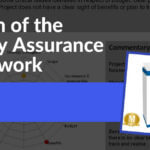You have invested valuable time, money and emotion into designing and constructing a PMO. The tools and processes have been created and published to the project managers. Sessions have been held with the project teams to ensure they understand how to use the tools and what is expected. So what is the reward for the hard working PMO manager? The next big challenge!
After you have mobilised your PMO, the next challenge is ensuring that the project teams effectively use the tools and processes that have been implemented so as to provide maximum benefit. If not all that investment will go to waste and the risk to successful delivery will increase.
The following can be used to help ensure that the PMO tools are used and add value.
1. Submission Reviews
Part of the role of the PMO is to review all of the regular submissions for quality and ensure that they make sense. This should be the first step to ensure that the tools are being used to control the project and provide an accurate representation of status. The review should ensure that the tools are being correctly completed AND that any commentary reflects RAG status, etc. For example, if the commentary reads “delays to xyz milestone due to critical resource not being available” yet the RAG status is Green, this is a mismatch and needs to be questioned.
Don’t be afraid in your role as the PMO to raise questions and ask for submissions to be updated. Part of your role is to ensure that any emerging themes are quickly identified and made visible to stakeholders, allowing them to make an informed decision.
2. Regular Catch-up Meetings
It is a good idea where possible to schedule regular catch up point meetings with the project manager. This will help build a good working relationship and allow for a better understanding of the workings of the project. This means the PMO can add more value by identifying where a submission does not include important information (this includes successes that are not being celebrated).
The meetings should be scheduled just after the submissions are due as this then allows for a joint review and any changes agreed.
3. PMO Quality Assurance (QA) Review
PMO QA reviews are a formal review of a project with the objective to identify areas that may prevent a project delivering the stated objectives. The review is usually at the request of the sponsor who wants an independent check that the project is set-up for success.
The review is typically conducted following a structured approach to test the set-up of the project across the key dimensions:
- Strategy & Business Objectives
- Scope
- Governance & Sponsorship
- Planning
- Budget
- Benefits
- Resources
- Risk Management
- Change Management
- Communication
The review is fact based and will identify strengths and weaknesses in the project. The findings and recommendations are then agreed and tracked so that any weaknesses are addressed. By doing this, it should improve the probability of success.
The next post will provide more information on the steps for conducting a PMO QA review.
Quality Assurance Resources
 If you would like to accelerate the implementation of a project quality assurance process, you may be interested in the Quality Assurance Framework by PM Majik.
If you would like to accelerate the implementation of a project quality assurance process, you may be interested in the Quality Assurance Framework by PM Majik.
This framework provides all of the tools, templates and guides to implement a project quality assurance process and executive reporting. The assurance review teamplate comes pre-populated with 120 ready to use review questions!
For more information visit Quality Assurance Framework.






